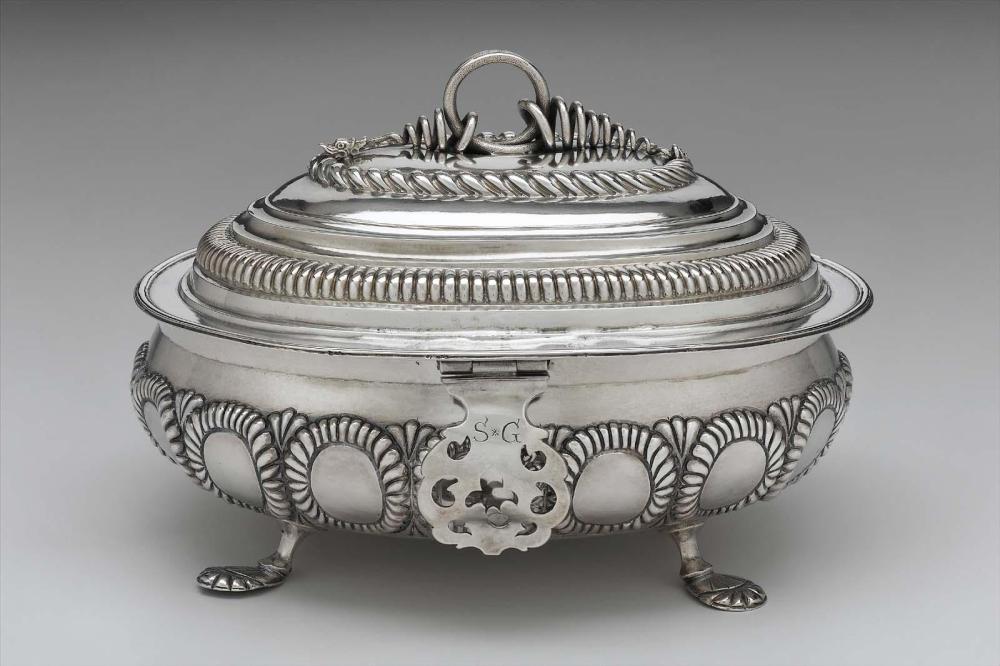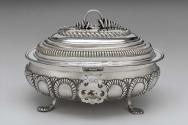Advanced Search
Sugar box
John Coney (American, 1655 or 1656–1722)
about 1700
Object Place: Boston, Massachusetts
Medium/Technique
Silver
Dimensions
Overall (h.x w. x d.): 16.7 x 20.3 x 14 cm (6 9/16 x 8 x 5 1/2 in.)
Credit Line
Bequest of Charles Hitchcock Tyler
Accession Number32.370
CollectionsAmericas
ClassificationsSilver hollowware
Sweetness and silver were luxuries purchased at a great price-in both human and economic terms-in the seventeenth and eighteenth centuries. Inhumane slave labor was used to extract silver ore from the mines at Potosi and elsewhere in South America and to grow and harvest sugar cane in the West Indies. Wealthy consumers then expended considerable sums to buy the imported sugar and to commission elaborate silver vessels, such as these three sugar boxes, to hold the precious substance on their tables.
Of the ten known survivingAmerican sugar boxes, nine, including the three examples shown here, are by John Coney or Edward Winslow of Boston, while one anomalous example is marked by Daniel Greenough of New Hampshire. Fashioned in the form of Italian cassoni (chests) and richly ornamented, these boxes are among the finest examples of early American silver. The elaborate chasing on each box may be the work of a skilled immigrant specialist. Nathaniel Gay may have been responsible for the chasing on the early Coney box (13.421), while Henry Hurst may have performed a similar role for the Winslow example (42.251).
In the seventeenth century, sugar was thought to possess special powers: one writer in 1637 argued that it "nourishes the body, generates good blood, cherishes the spirit, makes people prolific, [and] strengthens children in the womb." The iconography of the boxes alludes to marriage, fecundity, and fertility, making them "colonial expressions of courtly love" perfectly suited to house a material thought to contain reproductive and amatory properties.
This text was adapted from Ward, et al., MFA Highlights: American Decorative Arts & Sculpture (Boston, 2006) available at www.mfashop.com/mfa-publications.html.
Of the ten known survivingAmerican sugar boxes, nine, including the three examples shown here, are by John Coney or Edward Winslow of Boston, while one anomalous example is marked by Daniel Greenough of New Hampshire. Fashioned in the form of Italian cassoni (chests) and richly ornamented, these boxes are among the finest examples of early American silver. The elaborate chasing on each box may be the work of a skilled immigrant specialist. Nathaniel Gay may have been responsible for the chasing on the early Coney box (13.421), while Henry Hurst may have performed a similar role for the Winslow example (42.251).
In the seventeenth century, sugar was thought to possess special powers: one writer in 1637 argued that it "nourishes the body, generates good blood, cherishes the spirit, makes people prolific, [and] strengthens children in the womb." The iconography of the boxes alludes to marriage, fecundity, and fertility, making them "colonial expressions of courtly love" perfectly suited to house a material thought to contain reproductive and amatory properties.
This text was adapted from Ward, et al., MFA Highlights: American Decorative Arts & Sculpture (Boston, 2006) available at www.mfashop.com/mfa-publications.html.
DescriptionElliptical, convex sides ornamented by 16 oval bosses surrounded by reeding and divided by repousse trefoils, flaring rim, stepped and domed hinged cover, piercing hasp engraved SG, pad feet. Band of reeding midway on cover, gadrooned ellipse around top across which coiled serpent forms ring handle.
Marks
Three marks: all heart-shaped with "I C" and cross or fleur de lis beneath
1. interior, center of bowl, facing toward the rear of the piece
2. and 3. on rim of lid above latch/lock, facing toward center of lid
1. interior, center of bowl, facing toward the rear of the piece
2. and 3. on rim of lid above latch/lock, facing toward center of lid
InscriptionsSG on hasp
ProvenanceSamuel Gardner of Salem, Massachusetts (1648-1724); the inventory of his grandson of the same name (1712-1769) listed "1 sugar box wt 23 oz". 1932, bequest of Charles Hitchcock Tyler to MFA. (Accession date: Sept 1, 1932)



